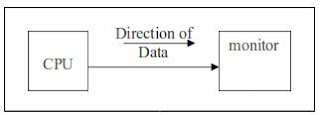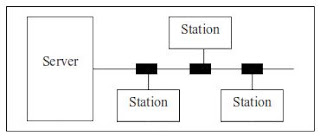NETWORK DATA FLOW!

Data communication between two systems can take place in three different modes: Simplex, half-duplex and full-duplex. In simplex mode, the communication is unidirectional, i.e., data flow takes place only one direction. In this mode, one of the two communication devices acts as a sender, and the other as a receiver. The data flow always takes place from the sender to the receiver. The communication can’t take place from the other side.
Examples for simplex communication are simple I/O devices like monitor or keyboard. Such devices always work in only one direction. They are used either for input or output purposes. But they can make use of the entire capacity of the channel to send the data in one direction.
Fig. : Simplex mode of communication
Half Duplex:
In this mode, each device can transmit as well as receive, but not at the same time. When one device is sending, the other can only receive, and vice versa. This mode of transmission is like a narrow bridge, which allows only one vehicle to move on it at either direction. When vehicles are moving in one direction, the vehicles from the other side must wait. Walkie Talkie and CB (Citizens Band) radios are both half-duplex systems.
The half-duplex mode is used in cases where there is no need for communication in both directions at the same time; the entire capacity of the channel can be utilized for each direction. The devices involved in half-duplex communication are called workstations. The workstations share the common communication media between them on timely basis but with fullest capacity.
Fig. : Half-duplex mode of communication
Full Duplex:
The full-duplex mode is like a two-way street with traffic flowing in both directions at the same time. This mode allows both the sender and the receiver to transmit and receive simultaneously. This mode of communication is also known as Duplex mode. Duplex mode allows signals moving in one direction share the capacity of the link with the signals moving in the other direction.
One common example of this type of communication is the telephone network. In telephone network, two people can talk to each other at the same time. This mode of data transfer is required when data transmission takes place from both sides of the network simultaneously. The capacity of the channel, however, must be divided between the two parties.
Fig. : Duplex communication
Node:
A node is a device, which is connected to a network via a communication link like cable. It can be a computer, printer or any other device capable of sending and/or receiving data gathered by other nodes on the network.
Distributed Processing:
Distributed processing is a way of performing a task in a network. In distributed processing, multiple computers are used to share the task and each and every computer performs certain aspects of the entire process.
Network Criteria:
Some of the important criteria that must be met by a computer network are: performance, reliability and security. Performance refers to the speed at which the data transmission takes place in a network. The performance of a network depends on a number of factors, which include the number of users, the type of transmission medium used, the capacities of the connected hardware and the efficiency of the software.
The performance of a network is often evaluated by two metrics: Throughput and Delay. Throughput determines the efficiency based on the number of packets transmitted at a specific period of time. It shows the frequency of data transfer in a network.
Delay is a metric, which indicates the time taken for transmitting the data from one place to another. Delay can be measured by calculating the time, such as transit time and response time. Transit time is the amount of time required for a message to travel from one device to another. Response time is the elapsed time between an inquiry and a response.
Reliability is a criterion which determines the frequency of failure in a network. It also involves the time taken for a link to recover from a failure, and the networks robustness in a catastrophe. Security deals with protecting data from unauthorized users, protection from loss or damage, and implementing policies and procedures for recovery from breaches and data loses.
Types of Network Connections:
A network comprises of two or more communication devices and a media for communication called link. A link is a communication pathway that transfers data from one device to another. All the computers in a network are connected to each other in any one of two ways:
- Point-to-Point connection and
- Multi Point connection
Point-to-Point Connection:
A point-to-point link connects two computers in a network using a dedicated link. The entire capacity of the link is reserved for transmission between those two devices. Most point-to-point connections use an actual length of wire or cable to connect the two ends.
Fig. : Point-to-Point Connection
Multipoint Connection:
A multi point (also called as multi drop) connection is a link which connects two or more devices through a common media. All the devices that are connected to the link share it among themselves.
In this type of connection, the capacity of the channel is shared either spatially or temporarily. If several devices can use the link simultaneously, it is a spatially shared connection. If users must take turns, it is a time shared connection.
Fig. : Multi point Connection










